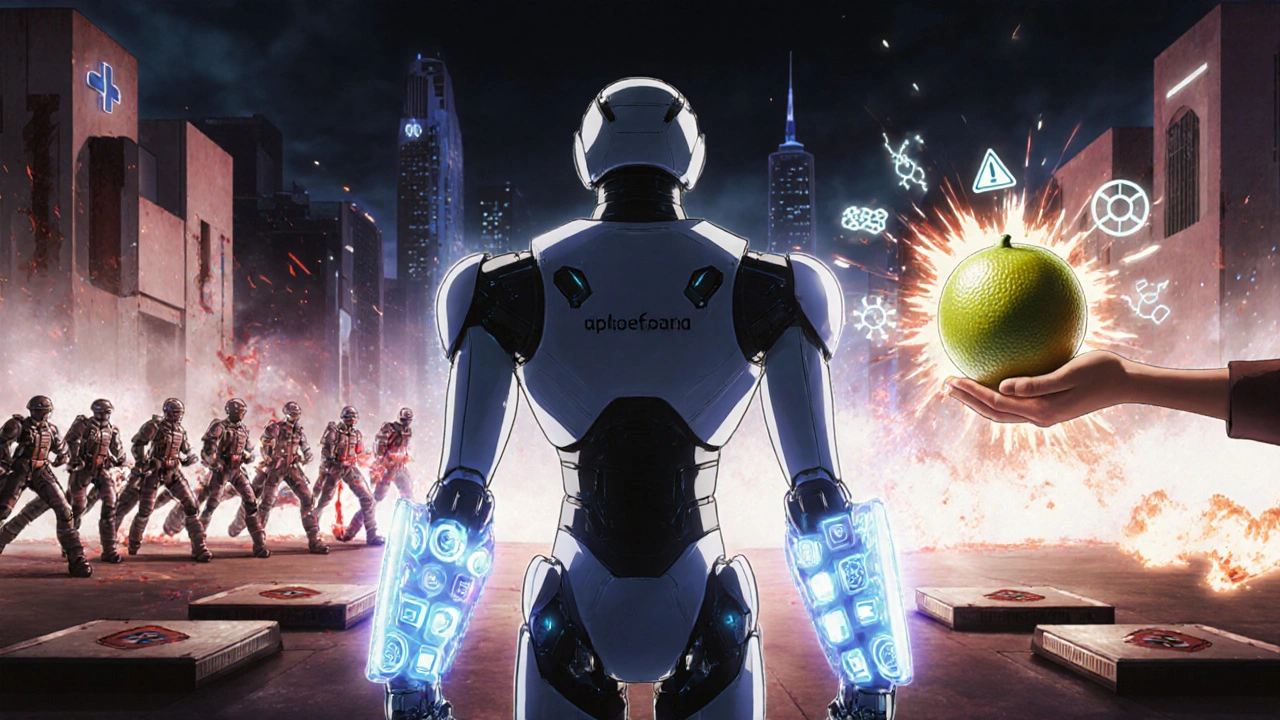Ever wonder why your headache pill works in 20 minutes but your antidepressant takes weeks? Or why your doctor warned you not to eat grapefruit with your blood pressure medicine? It’s not magic. It’s chemistry. Every medicine you take is a carefully designed chemical that interacts with your body in specific, measurable ways. Understanding how medicines work isn’t just for doctors-it’s the key to using them safely.
Medicines Are Chemical Keys That Fit Biological Locks
Your body runs on signals. Nerves fire, hormones circulate, cells communicate. Medicines don’t fix broken parts like a mechanic fixes a car. They tweak the signals. Think of it like a lock and key. Receptors on your cells are the locks. Medicines are the keys. Some keys turn the lock and turn the signal on-that’s an agonist. Others jam the lock so nothing else can turn it-that’s an antagonist.Take aspirin. It doesn’t just "take away pain." It blocks an enzyme called COX-1, which makes chemicals that cause inflammation and pain. No enzyme activity? Less pain. Less swelling. Simple. But not all medicines are this straightforward. SSRIs like fluoxetine (Prozac) work by blocking the serotonin transporter-a protein that normally pulls serotonin back into nerve cells after it’s sent a signal. By plugging that transporter, serotonin stays longer in the space between nerves, helping mood signals get through. It’s not adding serotonin. It’s keeping what’s already there from being recycled too fast.
And then there are drugs like levothyroxine for hypothyroidism. It’s not a stimulant. It’s a replacement. Your thyroid isn’t making enough hormone, so you take a synthetic version that your body treats exactly like its own. No trick. No guesswork. Just filling a gap.
How Your Body Handles Medicine-And Why It Matters
The medicine doesn’t just appear where it needs to go. It has to travel. And that journey changes it.If you swallow a pill, it starts in your stomach, moves to your intestines, and gets absorbed into your bloodstream. But here’s the catch: your liver doesn’t just sit there. It’s a chemical factory. The first time your medicine passes through the liver after being absorbed, it gets broken down. This is called the first-pass effect. For some drugs, like propranolol, up to 90% of the dose is destroyed before it ever reaches your heart. That’s why oral doses are often much higher than IV doses.
Then there’s the blood-brain barrier. It’s a protective wall that keeps toxins out of your brain. But it also blocks most drugs. That’s why Parkinson’s patients take a combination of carbidopa and levodopa (Sinemet®). Levodopa can slip through the barrier. Carbidopa stops the body from breaking it down too soon. Together, they deliver the right amount to the right place.
And once in your blood? Most drugs-up to 98%-stick to proteins like albumin. That’s not bad. It’s like putting the drug on pause. Only the small fraction that’s floating free can interact with receptors. That’s why drug interactions happen. If you take another medicine that also binds to those same proteins, it can kick your drug off, suddenly flooding your system with too much active medicine. Warfarin, for example, is 99% protein-bound. Sulfonamide antibiotics can displace it, causing dangerous bleeding.

Why Understanding Mechanism Makes Medicines Safer
Knowing how a drug works isn’t just academic. It’s the difference between guessing and knowing what to watch for.Take statins. They block HMG-CoA reductase, an enzyme your liver uses to make cholesterol. That’s their mechanism. Because we know this, we can monitor cholesterol levels to see if the dose is right. We also know that statins can cause muscle pain because they interfere with muscle cell energy production. Patients who understand this are 3.2 times more likely to report early muscle soreness-before it turns into rhabdomyolysis, a rare but life-threatening breakdown of muscle tissue.
Contrast that with lithium, used for bipolar disorder. We still don’t fully understand how it works. It affects multiple brain systems. That’s why its safety window is so narrow. Blood levels must stay between 0.6 and 1.2 mmol/L. Go a little higher? Tremors, confusion, even seizures. Go lower? No mood control. Because we can’t pinpoint the exact target, we have to monitor blood levels constantly. No room for error.
And then there’s trastuzumab (Herceptin). It only works on breast cancers that overexpress the HER2 protein. Before treatment, patients get tested. If they don’t have HER2, the drug won’t help-and they’ll avoid unnecessary side effects like heart damage. This is precision medicine in action. Mechanism-driven safety.
When Medicines Are Safe-And When They’re Not
A medicine isn’t safe just because it’s approved. It’s safe when it’s used the right way, for the right person, at the right dose.Warfarin is a classic example. It blocks vitamin K, which your body needs to make clotting factors. That’s why you’re told to eat consistent amounts of leafy greens. One day you eat a big salad with 800 mcg of vitamin K. The next day, nothing. Your INR (a blood test for clotting time) swings wildly. Too high? Risk of bleeding. Too low? Risk of stroke. Patients who understand this connection are far less likely to end up in the ER.
MAO inhibitors for depression are another case. They stop an enzyme that breaks down tyramine, a chemical in aged cheese, cured meats, and tap beer. If you eat those foods while on an MAOI, tyramine builds up, causing a sudden, dangerous spike in blood pressure. The FDA’s MedWatch database shows 32% of adverse events for these drugs happen because patients didn’t know about this interaction.
Even antibiotics aren’t harmless. Penicillin kills bacteria by breaking their cell walls. But if you don’t finish the course, you’re not just leaving behind the weak bugs-you’re leaving behind the ones that survived because they had a mutation. Those become the next generation. That’s how antibiotic resistance starts.

What You Can Do to Use Medicines Safely
You don’t need a pharmacology degree to use medicines safely. You just need to ask the right questions.- Ask: "What is this medicine supposed to do in my body?" Not "what does it treat?"-but how. Is it blocking something? Replacing something? Boosting something?
- Ask: "What should I watch for?" If you know the mechanism, you know the warning signs. Statins → muscle pain. SSRIs → nausea or anxiety at first. Warfarin → unusual bruising or bleeding.
- Ask: "Are there foods, drinks, or other medicines I need to avoid?" Grapefruit. Alcohol. St. John’s wort. These aren’t random warnings. They’re direct interactions with how the drug is processed or works.
- Never stop or change a dose without talking to your doctor. Especially with antidepressants, seizure meds, or heart drugs. Your body adapts. Stopping suddenly can cause withdrawal, rebound symptoms, or dangerous spikes.
- Use one pharmacy. They track everything you take. A pharmacist can spot interactions your doctor might miss.
Pharmacists spend an average of 8.7 minutes per patient explaining these details. And studies show that when patients get this info with visual aids-like diagrams of receptors or simple analogies ("SSRIs are like putting a cork in the serotonin recycling tube")-they understand 42% better.
The Future: Safer Medicines Through Better Understanding
The FDA’s "Pharmacology 2030" initiative is pushing for every new drug to have a fully mapped mechanism before approval. Why? Because drugs with clear mechanisms have 34% fewer safety-related label changes after they hit the market.Researchers are now using genetic data to predict who’s likely to have bad reactions. The NIH’s All of Us program found that 28% of adverse drug events are tied to genetic differences in how people metabolize or respond to drugs. In the next few years, we’ll see blood tests that tell you: "This statin will work for you. This one might cause muscle damage. Try this alternative."
And soon, digital twins-computer models of your body based on your genes, age, weight, and health history-could simulate how a drug will act in you before you even take it. Imagine avoiding side effects before they happen.
But for now, the best tool you have is knowledge. Not the kind from a pamphlet. The kind that comes from understanding how your medicine works at the molecular level. Because when you know how it works, you know when it’s safe-and when it’s not.
How do medicines know where to go in the body?
Medicines don’t "know" where to go. They travel through the bloodstream and interact with cells that have the right receptors-like a key fitting into a lock. Only cells with those specific receptors respond. That’s why some drugs affect only the brain, others only the gut, and others only the liver. It’s chemistry, not GPS.
Why do some medicines take days or weeks to work?
It depends on what they’re changing. Painkillers like ibuprofen block enzymes right away-so you feel relief fast. But antidepressants or thyroid meds work by changing gene expression or hormone levels over time. Your body needs days or weeks to adjust its systems. It’s not the drug being slow-it’s your body catching up.
Can I take my medicine with food?
Sometimes yes, sometimes no. Some medicines need an empty stomach to be absorbed properly (like antibiotics such as tetracycline). Others, like statins, work better with food because they’re fat-soluble. Grapefruit juice can interfere with over 85 drugs by blocking enzymes in your gut that break them down-leading to dangerous buildup. Always check the label or ask your pharmacist.
Are natural supplements safer than prescription drugs?
No. "Natural" doesn’t mean safe. St. John’s wort can interfere with antidepressants, birth control, and blood thinners. Kava can damage the liver. Many herbal products aren’t tested for interactions or purity. A 2023 FDA report found 23% of herbal supplements contained unlisted pharmaceuticals. Treat supplements like medicines-ask about mechanism and risks.
What should I do if I miss a dose?
It depends on the drug. For antibiotics, missing a dose can lead to resistance. For blood pressure meds, skipping one might not cause immediate harm but can raise risk over time. For insulin or seizure meds, missing a dose can be dangerous. Never double up unless instructed. Check the patient leaflet or call your pharmacist. They’ll tell you what’s safe based on the drug’s half-life and mechanism.
Why do some people have side effects and others don’t?
Genetics, age, liver and kidney function, and other medicines all play a role. Some people have gene variants that make them metabolize drugs too fast or too slow. Others have weaker kidneys and can’t clear the drug effectively. That’s why two people on the same dose can have completely different experiences. It’s not luck-it’s biology.
